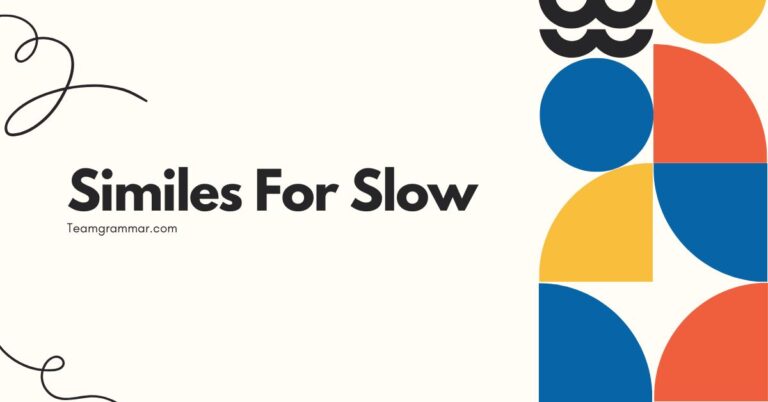30 Similes for Summer: A Comprehensive Guide to Figurative Language
Summer, with its vibrant imagery and sensory experiences, provides a rich landscape for figurative language. Similes, in particular, offer a powerful tool to capture the essence of the season.
This article delves into the world of similes, exploring their definition, structure, and usage, specifically within the context of summer. Understanding similes will enhance your writing, allowing you to create vivid descriptions and engaging narratives.
This guide is designed for English language learners, writers seeking to improve their descriptive abilities, and anyone interested in the art of figurative language.
By mastering the use of similes, you can transform ordinary descriptions into extraordinary expressions, capturing the unique beauty and feeling of summer in your writing. Whether you are a student, a seasoned writer, or simply someone who enjoys playing with words, this comprehensive guide will equip you with the knowledge and skills to effectively use similes to paint a picture of summer that is as memorable as it is evocative.
Get ready to dive into a world where language blossoms like a summer garden!
Table of Contents
- Definition of a Simile
- Structural Breakdown of a Simile
- Types of Similes
- Examples of Similes for Summer
- Usage Rules for Similes
- Common Mistakes When Using Similes
- Practice Exercises
- Advanced Topics in Similes
- Frequently Asked Questions
- Conclusion
Definition of a Simile
A simile is a figure of speech that directly compares two different things using the words “like” or “as.” The purpose of a simile is to create a vivid image or to emphasize a particular quality shared by the two things being compared. Similes are essential tools in descriptive writing, allowing authors to paint a picture for the reader and to evoke specific emotions or sensations.
They are a type of figurative language, meaning that they are not meant to be taken literally but rather to convey a deeper meaning or create a more impactful image.
In essence, a simile asserts that one thing issimilarto another. This comparison helps the reader understand the first thing in a new or more insightful way.
For example, saying “The sun is like a giant orange” helps the reader visualize the sun’s color and shape more clearly. The effectiveness of a simile lies in its ability to draw connections between seemingly unrelated things, revealing unexpected similarities and creating a memorable impression.
Structural Breakdown of a Simile
A simile typically consists of three key components: the subject, the linking word (“like” or “as”), and the object of comparison. Understanding each element is crucial for constructing effective and meaningful similes.
- Subject: This is the thing being described or compared. It is the focal point of the simile.
- Linking Word: This is the word that establishes the comparison, usually “like” or “as.” It indicates that the subject and object of comparison share a similar quality.
- Object of Comparison: This is the thing to which the subject is being compared. It should share a notable characteristic with the subject to make the simile effective.
The structure can be represented as follows:
Subject + Linking Word + Object of Comparison
For example, in the simile “The summer day was as hot as a furnace,” the subject is “The summer day,” the linking word is “as,” and the object of comparison is “a furnace.” This structure clearly conveys the intensity of the summer heat by comparing it to the extreme heat of a furnace.
It’s important that the comparison is logical and understandable. A good simile makes a clear connection between the subject and the object of comparison.
The more unexpected and insightful the comparison, the more effective the simile will be in capturing the reader’s attention and creating a lasting impression.
Types of Similes
Similes can be categorized based on the nature of the comparison they make. While the basic structure remains the same, the effect and purpose can vary depending on whether the comparison is positive, negative, or even ironic.
Positive Similes
Positive similes highlight favorable qualities or characteristics. These similes are used to emphasize the positive aspects of the subject by comparing it to something that is generally considered desirable or beneficial.
They evoke pleasant images and positive emotions.
For example, “The lemonade was as refreshing as a cool breeze” is a positive simile because it compares the lemonade to something pleasant and desirable (a cool breeze). This type of simile is often used to create a sense of joy, satisfaction, or well-being.
Negative Similes
Negative similes, conversely, highlight unfavorable qualities or characteristics. They are used to emphasize the negative aspects of the subject by comparing it to something that is generally considered undesirable or unpleasant.
They can evoke feelings of disgust, discomfort, or disapproval.
For example, “The sunburn was like a burning fire on my skin” is a negative simile because it compares the sunburn to something painful and undesirable (a burning fire). This type of simile is often used to create a sense of discomfort, pain, or negativity.
Ironic Similes
Ironic similes use comparison to convey the opposite of what is literally stated. These similes often rely on sarcasm or understatement to create a humorous or critical effect.
The effectiveness of an ironic simile comes from the contrast between the literal comparison and the intended meaning.
For example, saying “He’s about as useful as a screen door on a submarine” is an ironic simile. The literal comparison suggests that the person is as useful as a screen door on a submarine, which is to say, not useful at all.
The irony lies in the obvious absurdity of the comparison, highlighting the person’s lack of usefulness in a humorous or sarcastic way.
Examples of Similes for Summer
Summer provides an abundance of inspiration for similes. From the scorching heat to the refreshing cool of the water, the season is full of vivid imagery that can be captured through figurative language.
Here are numerous examples of similes related to various aspects of summer.
Summer Weather Similes
Summer weather is often extreme, ranging from intense heat to sudden storms. Similes can effectively capture these weather phenomena.
The following table provides a selection of similes describing summer weather. These examples illustrate how similes can be used to convey the intensity and variability of summer weather conditions.
| Simile | Explanation |
|---|---|
| The sun was like a blazing furnace in the sky. | Emphasizes the intense heat of the sun. |
| The air was as thick as soup. | Describes the heavy humidity of a summer day. |
| The rain fell like a curtain of tears. | Conveys the heavy and continuous nature of a summer rainstorm. |
| The wind was as gentle as a whisper. | Describes a light and soft summer breeze. |
| The heat was like a physical weight pressing down on us. | Illustrates the oppressive feeling of extreme heat. |
| The sky was as blue as a robin’s egg. | Describes the clear and vibrant color of the summer sky. |
| The clouds were like fluffy cotton balls drifting across the sky. | Paints a picture of light and airy clouds. |
| The lightning flashed like a camera bulb. | Conveys the sudden and intense brightness of lightning. |
| The thunder roared like a freight train. | Describes the loud and rumbling sound of thunder. |
| The humidity was as sticky as honey. | Illustrates the uncomfortable feeling of high humidity. |
| The sunset was like a painting splashed across the horizon. | Captures the beauty and artistry of a summer sunset. |
| The heat shimmered like a mirage on the road. | Describes the visual distortion caused by intense heat. |
| The breeze was as welcome as a cold drink on a hot day. | Emphasizes the refreshing nature of a summer breeze. |
| The sun beat down like a hammer. | Conveys the forceful and relentless nature of the sun’s rays. |
| The storm rolled in like an angry beast. | Illustrates the power and intensity of a summer storm. |
| The fog hung in the air like a damp blanket. | Describes the heavy and clinging nature of summer fog. |
| The temperature soared like a rocket. | Conveys the rapid increase in temperature. |
| The air smelled as sweet as honeysuckle. | Describes the pleasant scent of summer air. |
| The sun dipped below the horizon like a coin falling into a well. | Paints a picture of the sun setting slowly. |
| The evening air was as still as a photograph. | Describes the calmness and tranquility of a summer evening. |
| The heat radiated off the pavement like an oven. | Emphasizes the intense heat radiating from the ground. |
| The summer sky was as endless as the ocean. | Illustrates the vastness and limitlessness of the summer sky. |
| The rain pattered on the roof like tiny fingers. | Describes the gentle sound of rain. |
| The wind howled like a wolf in the night. | Conveys the strong and mournful sound of the wind. |
| The clouds gathered like conspirators plotting a storm. | Paints a picture of ominous and gathering clouds. |
Summer Activities Similes
Summer is a time for outdoor activities, from swimming to hiking to simply relaxing in the sun. Similes can capture the essence of these experiences.
The following table provides a variety of similes that describe common summer activities. These examples show how similes can add depth and color to descriptions of summer pastimes.
| Simile | Explanation |
|---|---|
| Swimming in the lake was like gliding through silk. | Describes the smooth and effortless feeling of swimming. |
| The campfire crackled like a symphony of tiny explosions. | Conveys the lively and dynamic sound of a campfire. |
| Hiking in the mountains was like climbing a staircase to the sky. | Illustrates the challenging and rewarding nature of hiking. |
| Relaxing on the beach was as peaceful as floating on a cloud. | Describes the tranquil and serene feeling of relaxing on the beach. |
| Playing volleyball was like a dance of athleticism and teamwork. | Emphasizes the coordination and collaboration involved in playing volleyball. |
| Fishing was as patient as watching paint dry. | Conveys the slow and deliberate nature of fishing. |
| Barbecuing was like conducting an orchestra of sizzling flavors. | Illustrates the complexity and artistry of barbecuing. |
| Sunbathing was like basking in the warmth of a loving embrace. | Describes the comforting and soothing feeling of sunbathing. |
| Watching fireworks was like witnessing a shower of stars. | Captures the dazzling and spectacular nature of fireworks. |
| Camping was like living in a world of natural wonder. | Emphasizes the immersive and awe-inspiring experience of camping. |
| The water felt like a thousand needles pricking my skin. | Describes the sensation of very cold water. |
| Catching fireflies was like capturing stars in a jar. | Illustrates the magical feeling of catching fireflies. |
| Riding a bike was like flying with wheels. | Conveys the freedom and exhilaration of riding a bike. |
| The picnic was as cheerful as a gathering of old friends. | Describes the joyful and convivial atmosphere of a picnic. |
| The music at the concert was like a wave washing over the crowd. | Emphasizes the powerful and immersive nature of live music. |
| The ice cream melted as fast as a snowball in July. | Conveys the speed at which ice cream melts in the summer heat. |
| The laughter of children was like music to my ears. | Describes the pleasant and joyful sound of children laughing. |
| The game of tag was as frantic as a chase scene in a movie. | Illustrates the fast-paced and energetic nature of a game of tag. |
| Building sandcastles was as creative as sculpting a masterpiece. | Emphasizes the artistic and imaginative nature of building sandcastles. |
| The hike was as challenging as climbing Mount Everest. | Conveys the difficulty and endurance required for the hike. |
| The pool was as crowded as a can of sardines. | Describes the feeling of being surrounded by people in a crowded pool. |
| The roller coaster ride was like a shot of adrenaline to the heart. | Illustrates the thrilling and exhilarating experience of riding a roller coaster. |
| The fireworks display was as spectacular as a supernova. | Emphasizes the grand and awe-inspiring nature of the fireworks. |
| The water park was like a playground for adults. | Describes the fun and carefree atmosphere of a water park. |
| The summer festival was as vibrant as a kaleidoscope. | Conveys the colorful and dynamic atmosphere of a summer festival. |
Summer Food Similes
Summer is a season of delicious food, from fresh fruits and vegetables to grilled delicacies and refreshing treats. Similes can capture the flavors and textures of these culinary delights.
The following table provides a selection of similes describing summer food. These examples illustrate how similes can enhance descriptions of the taste and texture of summer delicacies.
| Simile | Explanation |
|---|---|
| The watermelon was as juicy as a sponge soaked in water. | Describes the high water content and refreshing quality of watermelon. |
| The ice cream was as smooth as velvet on my tongue. | Conveys the creamy and luxurious texture of ice cream. |
| The lemonade was as tart as a lemon grove. | Emphasizes the sour and tangy flavor of lemonade. |
| The corn on the cob was as sweet as candy. | Describes the sugary and delicious taste of fresh corn. |
| The grilled steak was as tender as butter. | Illustrates the soft and easily cut texture of a perfectly grilled steak. |
| The salad was as crisp as a freshly picked apple. | Describes the crunchy and refreshing texture of a summer salad. |
| The peaches were as ripe as a summer sunset. | Conveys the perfect ripeness and color of summer peaches. |
| The berries were like tiny jewels bursting with flavor. | Illustrates the small size and intense taste of summer berries. |
| The iced tea was as refreshing as a dip in a cool pool. | Describes the thirst-quenching and invigorating quality of iced tea. |
| The barbecue sauce was as spicy as a dragon’s breath. | Emphasizes the intense heat and flavor of barbecue sauce. |
| The tomatoes were as plump as water balloons. | Describes the juicy and full appearance of ripe tomatoes. |
| The salsa was as zesty as a mariachi band. | Conveys the lively and flavorful nature of salsa. |
| The popsicle was as cold as an iceberg. | Illustrates the freezing temperature of a popsicle. |
| The hot dogs were as salty as the ocean. | Describes the savory and salty taste of hot dogs. |
| The s’mores were as gooey as melted marshmallows. | Emphasizes the sticky and delicious texture of s’mores. |
| The watermelon juice ran down my chin like a waterfall. | Describes the excessive juiciness of the watermelon. |
| The fruit punch was as colorful as a rainbow. | Illustrates the vibrant and varied colors of fruit punch. |
| The potato salad was as creamy as whipped clouds. | Describes the smooth and rich texture of potato salad. |
| The veggie burger was as dense as a brick. | Emphasizes the heavy and filling nature of the veggie burger. |
| The lemonade quenched my thirst like a cool rain. | Describes the refreshing and thirst-quenching quality of lemonade. |
| The sweet tea was as comforting as a warm hug. | Illustrates the soothing and pleasant nature of sweet tea. |
| The peach cobbler was as warm as a summer evening. | Describes the comforting and pleasant warmth of peach cobbler. |
| The burger was as stacked as a skyscraper. | Emphasizes the height and fullness of the burger. |
| The corn bread was as crumbly as dry sand. | Describes the texture of the corn bread. |
| The coleslaw was as tangy as a lemon. | Illustrates the tangy flavor of the coleslaw. |
Summer Nature Similes
Summer is a time when nature is in full bloom. Similes can capture the beauty and vibrancy of the natural world during this season.
The following table provides a selection of similes describing summer nature. These examples illustrate how similes can be used to paint vivid pictures of the natural world during the summer months.
| Simile | Explanation |
|---|---|
| The grass was as green as an emerald. | Emphasizes the vibrant green color of summer grass. |
| The flowers were like a riot of colors in the garden. | Describes the diverse and vibrant colors of summer flowers. |
| The trees were as lush as a tropical rainforest. | Illustrates the full and abundant foliage of summer trees. |
| The lake was as still as a mirror. | Describes the calm and reflective surface of a lake. |
| The stars were like diamonds scattered across the night sky. | Conveys the brilliance and beauty of stars on a summer night. |
| The fireflies were like tiny sparks dancing in the dark. | Illustrates the magical and whimsical nature of fireflies. |
| The crickets chirped like a chorus of tiny musicians. | Describes the rhythmic and harmonious sound of crickets. |
| The leaves rustled like whispers in the wind. | Conveys the soft and subtle sound of leaves rustling. |
| The sunset was as vibrant as a painter’s palette. | Illustrates the rich and varied colors of a summer sunset. |
| The ocean was as vast as eternity. | Emphasizes the immense and boundless nature of the ocean. |
| The meadow was as vibrant as a dream. | Describes the lush and colorful nature of the meadow. |
| The forest was as shaded as a cave. | Illustrates the cool and shaded environment of the forest. |
| The birds sang as sweetly as angels. | Describes the pleasant and melodious sound of birdsong. |
| The mountains stood as tall as giants. | Emphasizes the imposing height of the mountains. |
| The river flowed as smoothly as silk. | Describes the smooth and effortless flow of the river. |
| The dew drops clung to the grass like tiny diamonds. | Illustrates the sparkling and precious appearance of dew drops. |
| The bees buzzed as busily as a factory. | Describes the active and industrious nature of bees. |
| The butterflies fluttered as gracefully as dancers. | Illustrates the elegant and delicate movement of butterflies. |
| The tall grass swayed like waves in the breeze. | Captures the gentle and rhythmic movement of the grass. |
| The lake shimmered like a pool of liquid silver. | Describes the shiny and reflective surface of the lake. |
| The wildflowers bloomed as freely as a child’s imagination. | Illustrates the unrestrained and colorful growth of wildflowers. |
| The trees stood as silent as statues. | Describes the stillness and quiet presence of the trees. |
| The scent of pine was as invigorating as a mountain breeze. | Emphasizes the refreshing and stimulating aroma of pine. |
| The moon shone as brightly as a spotlight. | Illustrates the intense brightness of the moon. |
| The stars twinkled like scattered fairy lights. | Describes the flickering and magical appearance of the stars. |
Summer Feeling Similes
Summer evokes a range of emotions, from joy and freedom to relaxation and contentment. Similes can capture these feelings in a powerful way.
The following table provides a selection of similes describing summer feelings. These examples illustrate how similes can convey the emotional impact of the summer season.
| Simile | Explanation |
|---|---|
| Summer vacation felt like a weight lifted off my shoulders. | Describes the feeling of relief and freedom from responsibilities. |
| The warm sun felt like a comforting embrace. | Conveys the soothing and pleasant sensation of the sun’s warmth. |
| The long days felt as endless as a dream. | Illustrates the expansive and timeless feeling of summer days. |
| Summer nights felt as magical as a fairy tale. | Describes the enchanting and whimsical atmosphere of summer nights. |
| The feeling of summer was like pure joy bubbling inside. | Conveys the sense of happiness and excitement associated with summer. |
| The freedom of summer felt as boundless as the sky. | Emphasizes the sense of liberation and possibility during summer. |
| The relaxation of summer was as deep as a peaceful slumber. | Illustrates the profound and restful nature of summer relaxation. |
| The excitement of summer adventures was like a spark igniting my soul. | Conveys the enthusiasm and anticipation of summer experiences. |
| The memories of summer were as sweet as honey. | Describes the cherished and enjoyable nature of summer memories. |
| The warmth of summer friendships felt as comforting as a fire. | Illustrates the supportive and nurturing nature of summer friendships. |
| The peace of summer evenings was as profound as meditation. | Describes the tranquil and calming atmosphere of summer evenings. |
| The laughter of summer days was like music to my ears. | Conveys the pleasant and joyful sound of laughter during summer. |
| The spirit of summer was as light as a feather. | Illustrates the carefree and joyful attitude of summer. |
| The magic of summer nights was as enchanting as a dream. | Describes the captivating and wondrous atmosphere of summer nights. |
| The joy of summer was as contagious as a smile. | Conveys the uplifting and infectious nature of summer happiness. |
| The adventures of summer were as thrilling as a roller coaster. | Illustrates the exciting and exhilarating nature of summer experiences. |
| The memories of summer were as bright as sunshine. | Describes the radiant and cherished nature of summer memories. |
| The warmth of summer love felt as comforting as a blanket. | Conveys the soothing and affectionate nature of summer romance. |
| The freedom of summer days was as liberating as flight. | Illustrates the sense of unrestricted and joyous freedom during summer. |
| The beauty of summer sunsets was as breathtaking as a masterpiece. | Describes the awe-inspiring and stunning nature of summer sunsets. |
Usage Rules for Similes
Using similes effectively involves following certain guidelines to ensure clarity, relevance, and impact. Here are some key usage rules to keep in mind:
- Ensure Relevance: The comparison should be logical and understandable. The two things being compared should share a common characteristic that is relevant to the description.
- Avoid Clichés: Try to avoid overused similes that have lost their impact. Strive for originality and creativity in your comparisons.
- Be Specific: The more specific the comparison, the more vivid and memorable the image will be. Avoid vague or general comparisons.
- Consider Context: The effectiveness of a simile can depend on the context in which it is used. Consider the tone, audience, and purpose of your writing.
- Maintain Consistency: Ensure that the simile fits with the overall style and tone of your writing. Avoid using similes that clash with the surrounding text.
For example, instead of saying “The day was as hot as hell,” which is a common cliché, you could say “The day was as hot as standing in front of an open furnace,” which is more specific and creates a more vivid image.
Common Mistakes When Using Similes
Several common mistakes can weaken the impact of similes. Being aware of these errors can help you craft more effective and compelling comparisons.
Here’s a table highlighting common mistakes and providing correct alternatives:
| Incorrect Simile | Correct Simile | Explanation |
|---|---|---|
| The sun was like hot. | The sun was like a furnace. | Missing object of comparison; needs a noun or noun phrase. |
| She runs as fast like a cheetah. | She runs as fast as a cheetah. | Using both “as” and “like” is redundant. |
| The day was as nice like a party. | The day was as nice as a party. | Using both “as” and “like” is redundant. |
| The heat was like summer. | The heat was like an oven. | The comparison is too vague and doesn’t provide a vivid image. |
| He is as tall like a tree. | He is as tall as a tree. | Using both “as” and “like” is incorrect. |
| The water was like wet. | The water was like liquid glass. | The comparison is too obvious and doesn’t add anything new. |
Practice Exercises
Test your understanding of similes with these practice exercises. Fill in the blanks to complete the similes, or rewrite the sentences using similes.
Exercise 1: Complete the Simile
| Question | Answer |
|---|---|
| 1. The lemonade was as refreshing as __________. | a cool breeze |
| 2. The sun was like __________ in the sky. | a giant orange |
| 3. The air was as thick as __________. | soup |
| 4. The rain fell like __________. | a curtain of tears |
| 5. The wind was as gentle as __________. | a whisper |
| 6. The heat was like __________. | a physical weight |
| 7. The sky was as blue as __________. | a robin’s egg |
| 8. The clouds were like __________ drifting across the sky. | fluffy cotton balls |
| 9. The lightning flashed like __________. | a camera bulb |
| 10. The thunder roared like __________. | a freight train |
Exercise 2: Rewrite the Sentence as a Simile
| Question | Answer |
|---|---|
| 1. The watermelon was very juicy. | The watermelon was as juicy as a sponge soaked in water. |
| 2. The ice cream was very smooth. | The ice cream was as smooth as velvet on my tongue. |
| 3. The lemonade was very tart. | The lemonade was as tart as a lemon grove. |
| 4. The corn on the cob was very sweet. | The corn on the cob was as sweet as candy. |
| 5. The grilled steak was very tender. | The grilled steak was as tender as butter. |
| 6. The salad was very crisp. | The salad was as crisp as a freshly picked apple. |
| 7. The peaches were perfectly ripe. | The peaches were as ripe as a summer sunset. |
| 8. The berries were tiny and flavorful. | The berries were like tiny jewels bursting with flavor. |
| 9. The iced tea was very refreshing. | The iced tea was as refreshing as a dip in a cool pool. |
| 10. The barbecue sauce was very spicy. | The barbecue sauce was as spicy as a dragon’s breath. |
Advanced Topics in Similes
For advanced learners, exploring the nuances of similes can lead to more sophisticated and impactful writing. Some advanced topics include:
- Extended Similes: These are similes that are developed over several sentences or even paragraphs, creating a more elaborate and detailed comparison.
- Metaphorical Similes: These similes use metaphors as the object of comparison, adding another layer of figurative language. For example, “Her smile was like a sunrise, a promise of a new day.”
- Subverted Similes: These similes intentionally break expectations by making unusual or unexpected comparisons, often for humorous or ironic effect.
Mastering these advanced techniques can elevate your writing and allow you to create truly unique and memorable similes.
Frequently Asked Questions
Here are some frequently asked questions
What is the difference between a simile and a metaphor?
A simile uses “like” or “as” to make a direct comparison, while a metaphor implies a comparison without using these words. For example, “The sun is like a giant orange” is a simile, while “The sun is a giant orange” is a metaphor.
Can a simile be negative?
Yes, a simile can be negative by comparing something to an undesirable quality or object. For example, “The heat was like a burning fire on my skin” is a negative simile.
How can I make my similes more creative?
To make your similes more creative, try to think outside the box and make unexpected comparisons. Use sensory details to create vivid images, and avoid clichés.
Is it okay to use similes in formal writing?
While similes are more common in creative writing, they can be used in formal writing if they enhance clarity and understanding. However, it’s important to use them sparingly and ensure they are appropriate for the tone and audience.
How do I avoid using clichés in my similes?
To avoid clichés, brainstorm unique and original comparisons. Think about specific details and sensory experiences that can help you create a fresh and memorable image.
Conclusion
Similes are a powerful tool for enhancing your writing and creating vivid descriptions. By understanding their structure, types, and usage rules, you can effectively use similes to capture the essence of summer and evoke specific emotions or sensations.
Whether you’re describing the scorching heat, the refreshing cool of the water, or the joy of summer activities, similes can help you paint a picture that is as memorable as it is evocative. So go ahead, embrace the art of figurative language, and let your creativity bloom like a summer garden!







